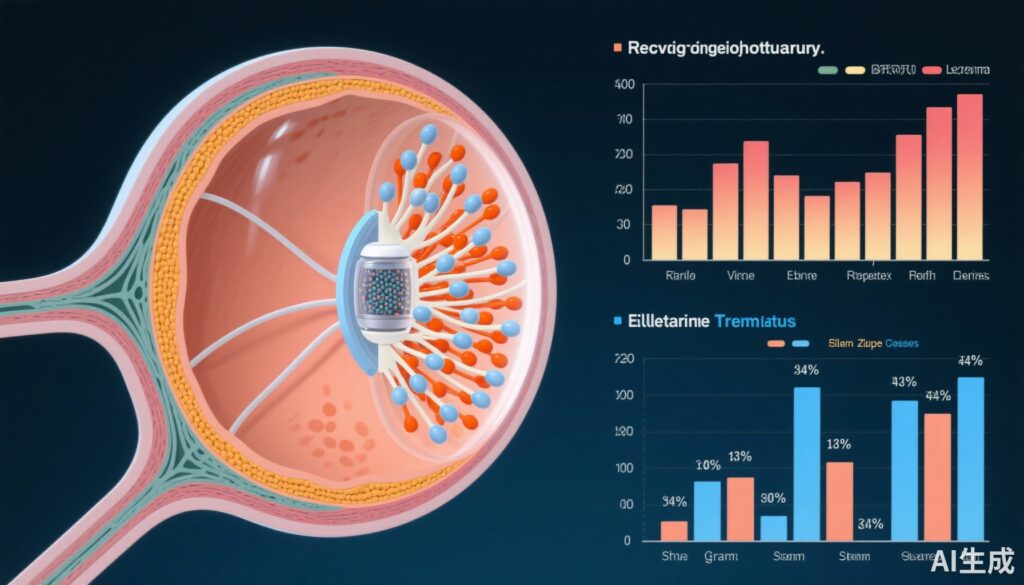Highlights
- Encapsulated cell therapy delivering ciliary neurotrophic factor (NT-501) reduces photoreceptor degeneration in MacTel type 2, demonstrated in rigorous, multicenter phase 3 randomized controlled trials.
- NT-501 treatment significantly slowed ellipsoid zone area (EZA) loss over 24 months, a key biomarker of photoreceptor integrity, compared to sham controls.
- Despite robust structure preservation, functional outcomes such as retinal sensitivity, reading speed, and patient-reported vision-related quality of life showed inconsistent improvement.
- NT-501 exhibited an acceptable safety profile, with transient miosis and delayed dark adaptation as the most notable adverse events, but no significant increase in serious adverse events or visual acuity loss.
Background
Macular telangiectasia type 2 (MacTel) is a progressive neurodegenerative retinal disease characterized by parafoveal telangiectatic capillaries and photoreceptor degeneration leading to vision loss. Currently, no approved therapies effectively slow disease progression. Ciliary neurotrophic factor (CNTF) is a promising neuroprotective cytokine with potential to preserve photoreceptors. Revakinagene taroretcel (NT-501) is a novel encapsulated cell technology implant releasing CNTF locally within the vitreous, designed to provide sustained neuroprotection without systemic exposure. Earlier phase 2 data revealed slowed retinal degeneration, prompting comprehensive phase 3 investigations.
Key Content
Chronological Development of Evidence for CNTF Therapy in MacTel
Preclinical studies established CNTF’s neuroprotective effects in retinal degenerative models by promoting photoreceptor survival and cellular repair. Phase 1 and 2 studies of NT-501 implants showed safety and potential efficacy signals in MacTel patients, evidenced by reduced photoreceptor structure loss with acceptable tolerability. Building on these foundations, the pivotal phase 3 NTMT-03 program was launched.
Phase 3 Trials: NTMT-03-A and NTMT-03-B
These identically designed, multicenter, randomized, sham-controlled phase 3 trials collectively enrolled 228 participants with MacTel. The primary outcome was the rate of change in ellipsoid zone area (EZA) over 24 months, an OCT-based biomarker of photoreceptor integrity.
– NTMT-03-A: NT-501 recipients (n=58) experienced significantly less EZA loss at 0.075 mm²/24 months compared to 0.166 mm²/24 months in sham controls (n=57), yielding a treatment effect of -0.091 mm² (95% CI, -0.125 to -0.056; P<0.001).
– NTMT-03-B: Similarly, NT-501 group (n=59) had EZA loss of 0.111 mm² versus 0.160 mm² in sham (n=54), difference -0.049 mm² (95% CI, -0.089 to -0.008; P=0.02).
Secondary endpoints including retinal sensitivity and reading speed were inconsistent between trials, with no significant differences in the NEI VFQ-25 scores or best-corrected visual acuity (BCVA).
Safety and Tolerability
Treatment-emergent serious adverse events were comparable between NT-501 and sham groups. The most common NT-501-associated adverse effects were miosis (14–17%) and delayed dark adaptation (17–24%), both transient and non-serious. Importantly, no significant increase in BCVA loss or intraocular inflammation was observed.
Mechanistic Insights and Translational Implications
The sustained delivery of CNTF by encapsulated cells likely promotes photoreceptor survival through activation of neuroprotective signaling pathways rather than direct restoration of visual function. The dissociation between structural preservation and functional endpoints suggests the complex nature of MacTel pathology involving vascular, neuronal, and glial components.
Expert Commentary
The NTMT-03 phase 3 trials affirm NT-501 as a pioneering disease-modifying approach in MacTel, the first to slow photoreceptor degeneration significantly. The robust imaging biomarker outcomes reinforce CNTF’s neuroprotective potential and validate encapsulated cell therapy as an innovative delivery platform for chronic retinal diseases.
However, the modest and inconsistent functional improvements highlight the challenge of translating structural salvage into meaningful visual benefits within the 2-year timeframe, underscoring the need for longer follow-up and combination strategies targeting vascular abnormalities.
Safety data are reassuring, especially the absence of immunogenicity or severe inflammation, vindicating the encapsulation technology. Noteworthy is the clinical relevance of monitoring subtle adverse effects like miosis and delayed dark adaptation, which clinicians should counsel patients about.
Guideline bodies currently lack MacTel-specific treatment recommendations; these phase 3 data may inform future consensus statements. Still, generalizability requires cautious interpretation given the highly selected trial populations and the relative rarity of MacTel.
Conclusion
NT-501 encapsulated cell therapy represents a significant advance for MacTel management, with compelling evidence for decelerating photoreceptor loss. This novel approach may shift the therapeutic paradigm toward neuroprotection in inherited and acquired retinal diseases. Future research should focus on combining CNTF therapy with adjunctive treatments to enhance functional outcomes and on identifying biomarkers predictive of clinical response.
References
- Chew EY, Gillies M, Jaffe GJ, et al. Cell-Based Ciliary Neurotrophic Factor Therapy for Macular Telangiectasia Type 2. NEJM Evid. 2025;4(8):EVIDoa2400481. doi:10.1056/EVIDoa2400481. PMID: 40693847.


